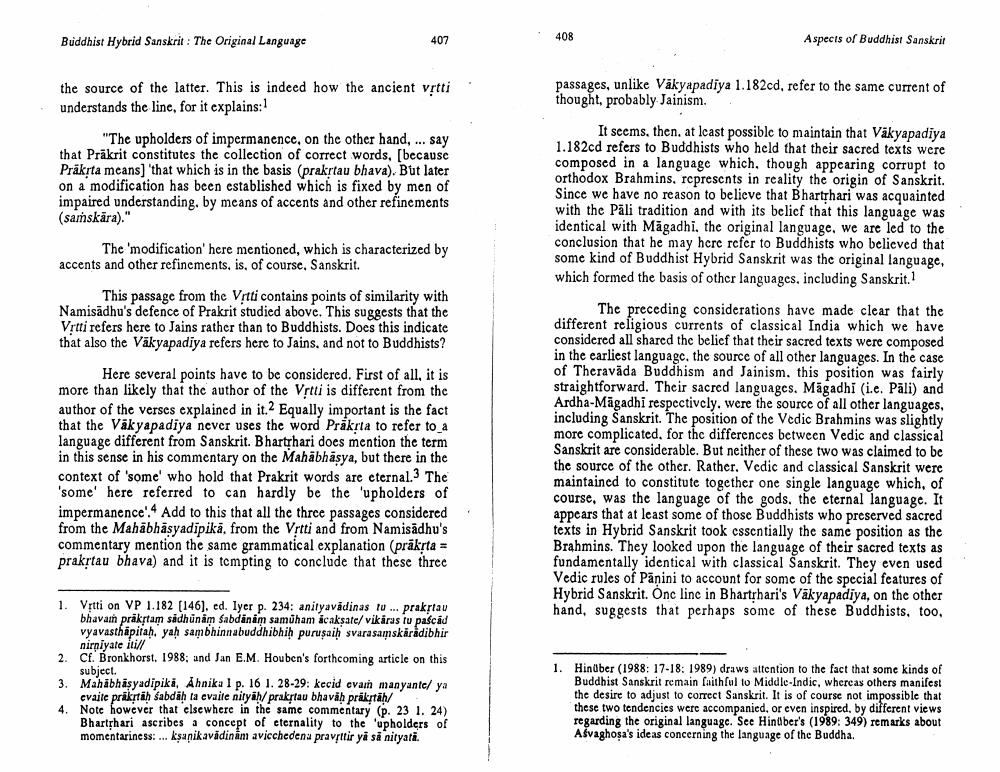Book Title: Buddhist Hybrid Sanskrit Original Language Author(s): Johannes Bronkhorst Publisher: Johannes Bronkhorst View full book textPage 7
________________ • Buddhist Hybrid Sanskrit: The Original Language 407 408 Aspects of Buddhist Sanskrit the source of the latter. This is indeed how the ancient vrtti understands the line, for it explains: passages, unlike Väkyapadiya 1.182cd, refer to the same current of thought, probably Jainism. "The upholders of impermanence, on the other hand, ... say that Präkrit constitutes the collection of correct words, [because Prakrta means that which is in the basis (prakrtau bhava). But later on a modification has been established which is fixed by men of impaired understanding, by means of accents and other refinements (saskāra)." It seems then, at last possible to maintain that Vákyapadiya 1.182cd refers to Buddhists who held that their sacred texts were composed in a language which, though appearing corrupt to orthodox Brahmins, represents in reality the origin of Sanskrit. Since we have no reason to believe that Bharthari was acquainted with the Pāli tradition and with its belief that this language was identical with Màgadhi, the original language, we are led to the conclusion that he may here refer to Buddhists who believed that some kind of Buddhist Hybrid Sanskrit was the original language, which formed the basis of other languages, including Sanskrit. The 'modification here mentioned, which is characterized by accents and other refinements, is, of course, Sanskrit. This passage from the Vitti contains points of similarity with Namisadhu's defence of Prakrit studied above. This suggests that the Vrtti refers here to Jains rather than to Buddhists. Does this indicate that also the Väkyapadiya refers here to Jains, and not to Buddhists? Here several points have to be considered. First of all, it is more than likely that the author of the Vrtui is different from the author of the verses explained in it.2 Equally important is the fact that the Väkyapadiya never uses the word Prakrta to refer to a language different from Sanskrit. Bharthari does mention the term in this sense in his commentary on the Mahabhâsya, but there in the context of 'some' who hold that Prakrit words are eternal.3 The 'some here referred to can hardly be the 'upholders of impermanence'. Add to this that all the three passages considered from the Mahabhasyadipikā, from the Vrtti and from Namisådhu's commentary mention the same grammatical explanation (pråkrta = prakstau bhava) and it is tempting to conclude that these three The preceding considerations have made clear that the different religious currents of classical India which we have considered all shared the belief that their sacred texts were composed in the earliest language, the source of all other languages. In the case of Theravada Buddhism and Jainism, this position was fairly straightforward. Their sacred languages. Magadhi (ie. Pali) and Ardha-Măgadhi respectively, were the source of all other languages, including Sanskrit. The position of the Vedic Brahmins was slightly more complicated, for the differences between Vedic and classical Sanskrit are considerable. But neither of these two was claimed to be the source of the other. Rather. Vedic and classical Sanskrit were maintained to constitute together one single language which, of course, was the language of the gods. the eternal language. It appears that at least some of those Buddhists who preserved sacred texts in Hybrid Sanskrit took csscntially the same position as the Brahmins. They looked upon the language of their sacred texts as fundamentally identical with classical Sanskrit. They even used Vedic rules of Panini to account for some of the special features of Hybrid Sanskrit. Onc linc in Bharthari's Väkyapadiya, on the other hand, suggests that perhaps some of these Buddhists, too, 1. Vitti on VP 1.182 (146), ed. lyer p. 234: anityavādinas tu ... praktau bhavain prakstam sådhunam Sabdanám samüham kcaksate/vikáras tu pascad vyavasthipitah. yah sambhinnabuddhibhiḥ purusa ih svara samskiridibhir nirniyate itill 2. Ct. Bronkhorst. 1988; and Jan E.M. Houben's forthcoming article on this subject. 3. Mahabhäsyadipiki, Ähnika I p. 16 I. 28-29: kecid cvain manyante/ ya evaite prikrah Sabdah ta evaite nityaprakstau bhavah praktäh/ Note however that elsewhere in the same commentary (p. 23 I. 24) Bhartrhari ascribes a concept of cternality to the 'upholders of momentariness: ... kapikavadinim avicchedenu pravpttir yi si nityati. 1. Hinüber (1988: 17-18: 1989) draws attention to the fact that some kinds of Buddhist Sanskrit remain faithful to Middle-Indic, whereas others manifest the desire to adjust to correct Sanskrit. It is of course not impossible that these two tendencies were accompanied, or even inspired by different views regarding the original language. See Hinüber's (1989: 349) remarks about Ašvaghosa's ideas concerning the language of the Buddha.Page Navigation
1 ... 5 6 7 8 9 10 11 12 13 14 15
